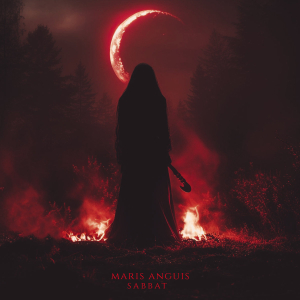
Welcome to the sounds of the Dark Realm…
Maris Anguis is, as far as I know, a very young outfit formed by Springfield, Illinois, U.S.A. based (yet Japan-originating) damsel Ryo Utasato, who is also (very) active under her own name (apparently she did win some awards), as well as under the monikers Insania and Cilvarium. With Sabbat, she offers a second Maris Anguis album via Slithering Black Records (see below for additional information). Once again, it was self-produced, with recording and mix done at the DarkSkys Studio. When it comes to this project, Ryo seeks inspiration in ancient history through ceremonial, spiritual and black magic themes.
That’s exactly what the concept behind Sabbat stands for (as the title might suggest). Witches and their covens meet to connect with nature and to communicate with the old ancient spirits. […] Under the red moonlight, the summoning of the lord of darkness begins. […] It has begun… Sabbat. The album deals with medieval gatherings of witches, dancing around the bonfire in the middle of the woods, seeking connection with dark creatures and entities from the Underworld.
From aural point, Maris Anguis creates a mighty imaginary world of doom and darkness, seeking inspiration in Dark Ambient, Post Industrial, Ritual Drone and the likes. Sabbat proudly continues the unique approach of last year’s Infernal Reign, yet it has its own, different nuances and completions. The material gets created through multiple synth lines and keyboard-manipulated drones, with the injection of different forms of percussion, some additional (female) voices, and a modest yet undeniably important amount of strings (I think she also uses the ‘erhu’), besides the use of field-recorded samples. Moreover, each single composition - there are ten (mainly lengthy, with a total running time of almost one hour) titles on Sabbat - has its own story to tell.
I won’t analyze all of them individually, because each single one is like one huge amalgam of interacting rhythms, textures, influences and interpretations. Very often (opener At Night is a perfect example), every few seconds things do change, develop, decrease and grow once more, always maintaining a balance of esoteric fairness and disturbing obscurity. The synths move over from illuminating passages to doomed fragments, moving over from droning heaviness to moonlit ambience, while the strings vary from down-earthed and orchestral towards totally alienated and turbulent. And the enormous application of percussions (different kinds of drums, as well as chimes and wooden plus metallic percussions; maybe also instruments like bodhran and tambourine) in most of the hymns expands the open-visioned, hallucinogen approach. The title-track is another example of the multi-visionary sonic approach, divided into several contrasting yet organically sequacious parts (mind the amazing drums and intoxicating synths towards the end, amongst so many other smoothly related sound effects and instrumental elements).
The influence of Industrial Music reappears quite often; sometimes bold and free (Seance has such excerpts), then again almost invisible in all modesty. The whole background sequence of Come Into Being too is based on somewhat mechanical rumbles and metallic sequences (which go well with the fascinating yet entangled arrangements.
Other compositions (or at least different excerpts), like the grand epos He Is Coming, focus on a militant heaviness, combative and victorious, with thunderous beats and / or full-symphonic orchestration and / or martial rhythms.
Yet then again, tranquility, meditation and introspection might rise up too. Imagine those misty atmospheres in Deep Red, for instance, translated via haunting whispers and long-stretched waves, dreamy melodies, and more (mind the orchestral and neo-martial elements too in the second half of this grandiose piece).
At moments, hints of (Nordic) Folk appear, quite often caused by the aforementioned ritualistic or shamanistic drums, yet also by some of the vocal parts. Take The Darkness Falls, for example, which opens with ethereal yet bombastic drones, ceremonial percussions and, eventually, really beautiful female chants (and some whispers). More dark-edged keyboard-waves follow, as well as tribal voices and multifarious percussions, whispers and samples. The Woods too is a track that injects several folkish and ritualistic elements within its droning and doomed orbit, while classical and eclectic details seem to create an eccentric yet attractive inner battle.
Sabbat is not an easy-listening record, in contradiction to many Dark Ambient releases. It needs several listens, and even after a few attentive turns, new elements seem to emerge. It’s a challenging idea, yet a satisfying one after each try-out. After some listens, the discomfortable first opinion evolves into a position of awe, reverence and apprehension.
Sabbat got digitally released via Providence, Rhode Island based Slithering Black Records, a quite young yet enormously interesting (and quite productive) label ‘that specializes in various genres of dark and atmospheric music […] often incorporating elements of horror and occultism’. I guess that this signing in between the label and Maris Anguis (at the end of Autumn 2023, there was a first result of this collaboration, called Infernal Reign [previously self-released, with other artwork]), totally fits within this intriguing collective of Ritual / Occult / Drone / Ambient artists (Handalien, Mike Benoit, insectarium, Scott Lawlor, Twisted Phobia, Omensworn and many more). Omen North took care of artwork and design too. And that cover artwork, well, what an intriguing (and once again: totally fitting) expression of visual artistry! It’s the concept, the color-palette and the details that make this ritualistic picture-like cover simply amazing.
https://slitheringblackrecords.bandcamp.com/album/sabbat
https://marisanguis.bandcamp.com/
https://soundcloud.com/ryo-utasato
